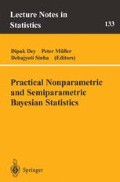Abstract
The customary objective of a group sequential design is the comparison of several treatments or populations. The evolutionary nature of such trials encourages the use of the Bayesian paradigm in the design, monitoring and analysis of these trials. Here we focus on the design issue for the case of continuous, possibly multivariate response at each trial. Our approach is descriptive. Given a model specification, a design is characterized by a number of interim evaluations, the group size for each interim look, and a set of stopping criteria which determine our decision at a given look. By simulating replications of the design we can summarize design performance in terms of when the trial was stopped and reason for stopping. Such simulation and evaluation requires a fully Bayesian model specification for each treatment. We take a nonparametric perspective for the likelihood specification by assuming that the data is drawn from a distribution which arises through Dirichlet process mixing. However, we distinguish a sampling or “what if” prior, reflecting illustrative differences between populations, from a fitting or skeptical prior assuming no differences. By drawing trials under the sampling model, while fitting the model under the fitting prior, Bayesian learning moves us from prior indifference to detection of differences. We illustrate with two examples, one having univariate response, the other bivariate response.
Access this chapter
Tax calculation will be finalised at checkout
Purchases are for personal use only
Preview
Unable to display preview. Download preview PDF.
References
Antoniak, C. E. (1974), “Mixtures of Dirichlet Processes with Applications to Nonparametric Problems”, The Annals of Statistics, 2, 1152–1174.
Berry, D. A. (1993), “A Case for Bayesianisrn in Clinical Trials”, Statistics in Medicine, 12, 1377–1393.
Berry, D. A. and Ho, C. H. (1988), “One-Sided Sequential Boundaries for Clinical Trials: A Decision-Theoretic Approach”, Biometrics, 44, 219–227.
Carlin, B. P., Kadane, J. B., and Gelfand, A. E. (1998), “Approaches for Optimal Sequential Decision Analysis in Clinical Trials”, Biometrics (to appear).
Escobar, M. D. and West, M. (1992), “Computing Bayesian Nonparametric Hierarchical Models”, Technical report, ISDS, Duke University.
Escobar, M. D. and West, M. (1995), “Bayesian Density Estimation and Inference Using Mixtures”, Journal of the American Statistical Association, 90, 577–588.
Ferguson, T. S. (1973), “A Bayesian Analysis of Some Nonparametric Problems”, The Annals of Statistics, 1, 209–230.
Freedman, L. S. and Spiegelhalter, D. J. (1989), “Comparison of Bayesian with Group Sequential Methods for Monitoring Clinical Trials”, Controlled Clin. Trials, 10, 357–367.
Gelfand, A. E. and Mukhopadhyay, S. (1995), “On Nonparametric Bayesian Inference for the Distribution of a Random Sample”, Canandian Journal of Statistics, 23, 411–420.
Gelfand, A. E. and Smith, A. F. M. (1990), “Sampling Based Approaches to Calculating Marginal Densities”, Journal of the American Statistical Association, 85, 398–409.
Gelfand, A. E. and Vlachos, P. K. (1995), “Bayesian Clinical Trial Design for Multivariate Categorical Response Models”, Technical Report 9501, Department of Statistics, The University of Connecticut.
Geller, N.L. and Pocock, S.J. (1987), “Interim Analyses in Randomized Clinical Trials: Ramifications and Guidelines for Practitioners”, Biometrics, 43, 213–223.
Kadane, J. B. (1995), “Prime Time for Bayes”, Controlled Clin. Trials, 16, 313–318.
Kadane, J. B. and Vlachos, P. K. (1998), “Hybrid Methods for Calculating Optimal Sequential Strategies: Data Monitoring for a Clinical Trial”, Technical report, Carnegie Mellon University.
Kuo, L. (1986), “Computations of Mixtures of Dirichlet Processes”, SIAM J. Sci. Statist. Comput. 7, 60–71.
Lewis, R. J. and Berry, D. A. (1994), “Group Sequential Clinical Trials: A Classical Evaluation of Bayesian Decision-Theoretic Design”, Journal of the American Statistical Association.
O’Brien, P. C. and Fleming, T. R. (1979), “A Multiple Testing Procedure for Clinical Trials”, Biometrics 35, 549–556.
Pocock, S.J. (1977), “Group Sequential Methods in the Design and Analysis of Clinical Trials”, Biometrica, 64, 191–199.
Spiegelhalter, D. J. and Freedman, L. S. (1988), “Bayesian Approaches to Clinical Trials (with discussion)”, in Bayesian Statistics 3 (eds: Bernardo, J.M., Berger, J.O., DeGroot, M., and Smith, A.F.M.), Oxford University Press, 453–477.
Spiegelhalter, D. J., Freedman, L. S., and Parmar, M. K. B. (1994), “Bayesian Approaches to Randomized Trials (with discussion)”Journal of the Royal Statistical Society, Series B, 157, 357–416.
Thall, P. F., Simon, R., and Estey, E. H. (1995), “Bayesian Sequential Monitoring Designs for Single-arm Clinical Trials with Multiple Outcomes”, Statist. in Medicine, 14, 357–379.
Vlachos, P. K. and Gelfand, A. E. (1996), “Bayesian Decision Theoretic Design for Group Sequential Medical Trials Having Multivariate Patient Response”, Technical Report 96–03, Department of Statistics, The University of Connecticut.
Editor information
Editors and Affiliations
Rights and permissions
Copyright information
© 1998 Springer Science+Business Media New York
About this chapter
Cite this chapter
Vlachos, P.K., Gelfand, A.E. (1998). Nonparametric Bayesian Group Sequential Design. In: Dey, D., Müller, P., Sinha, D. (eds) Practical Nonparametric and Semiparametric Bayesian Statistics. Lecture Notes in Statistics, vol 133. Springer, New York, NY. https://doi.org/10.1007/978-1-4612-1732-9_6
Download citation
DOI: https://doi.org/10.1007/978-1-4612-1732-9_6
Publisher Name: Springer, New York, NY
Print ISBN: 978-0-387-98517-6
Online ISBN: 978-1-4612-1732-9
eBook Packages: Springer Book Archive

